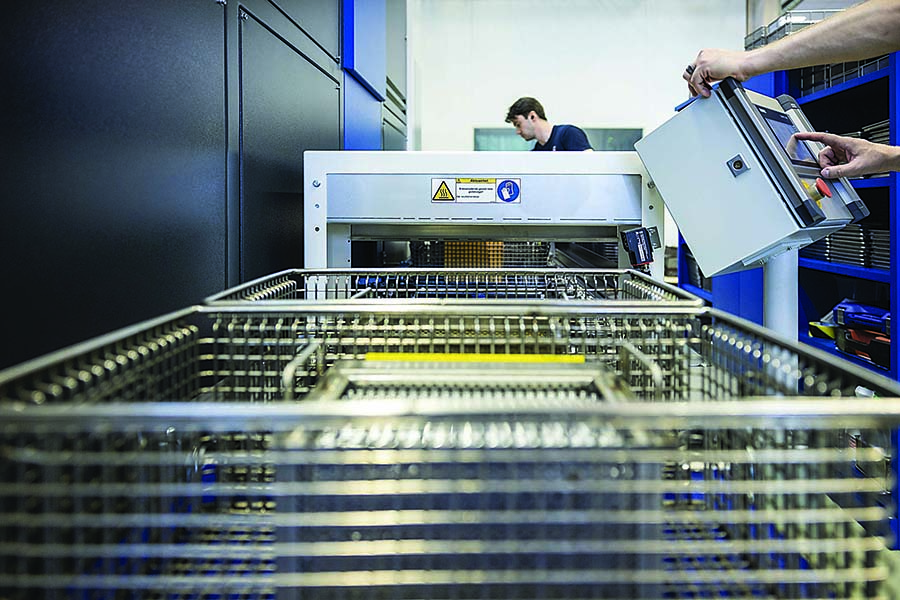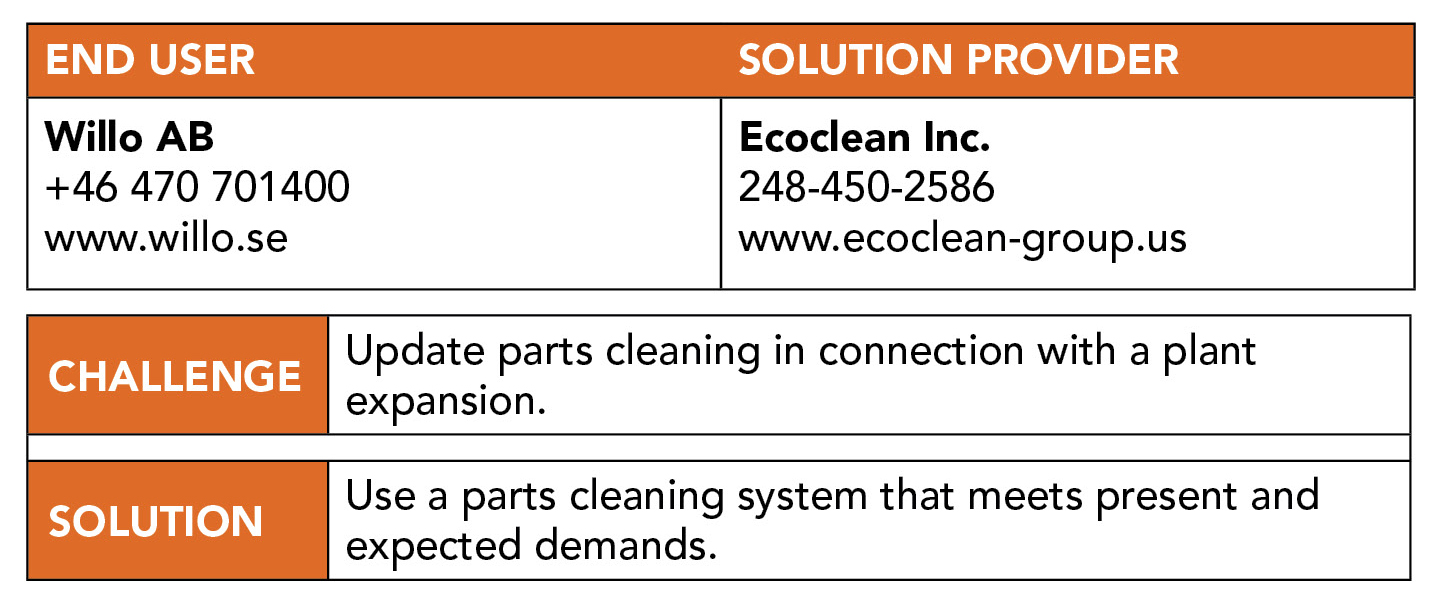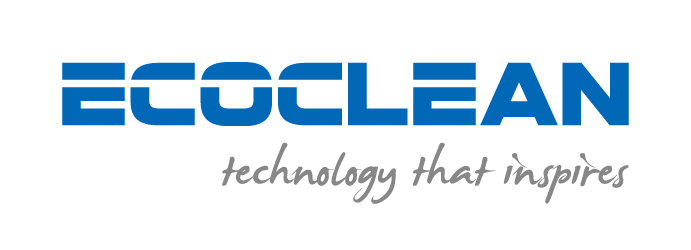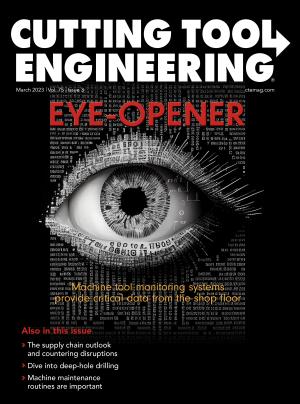Manufacturing high-precision parts with complex interior geometries requires a high level of quality along the entire production chain. To be optimally prepared for future cleanliness requirements, a Swedish manufacturer needed to replace one of its existing solvent cleaning systems.
When Willo AB founder Willy Loeffel came from Switzerland to Växjö in Sweden in 1956, he brought entrepreneurial spirit and extensive technical know-how about operating sliding spindle lathes. The second-generation, family-run business specializes in machining small, complex parts primarily for the medical, power engineering and valve technology industries. Since its start, Willo has seen double-digit growth rates on average in these fields. This growth is why the manufacturer plans to expand its production area by about 1,500 sq. m (16,146 sq. ft.) in the next two years by adding a building.
The list of workpiece materials includes steel, aluminum, titanium, copper, brass and plastics. According to the company, its state-of-the-art machinery ensures that parts meet tight-tolerance specifications.
“This also concerns parts cleaning, where particles and residues of machining oil have to be removed from exterior and interior part contours,” said Technical Manager Peter Hultkvist. “On the one hand, the quality of downstream processes, such as heat treatment or coating, depends on this cleanliness. On the other hand, the observance of defined cleanliness specifications in final cleaning is a must for both potential further processing in validated processes at our customers’ facilities and for the function of the parts in the final product.”


The company has cleaned parts with solvent cleaning systems from Filderstadt, Germany-based Ecoclean GmbH for more than two decades. (Ecoclean Inc. is in Southfield, Michigan.) When Willo decided to replace its almost 25-year-old system, it was clear that the new cleaning system had to meet not only present but future cleanliness requirements.
“It was important for us that we would be optimally prepared for our customers’ future higher demands regarding particle and film-type cleanliness specifications, process consistency and productivity,” Hultkvist said. “Maximum process stability, as well as being prepared for automatic data transfer to our MRP, were further requirements.”
Another criterion was the best possible use of the available production time by optimally selecting the cleaning steps for the system. Willo discussed these issues with several cleaning system manufacturers and opted for Ecoclean’s EcoCcompact based on the system’s features and Willo’s experience with the company’s cleaning systems, service and know-how.
The new solvent cleaning system is compact at 3,200 mm × 1,600 mm × 2,450 mm (126"×63"×96.4") and operates under full vacuum. Willo uses the system with the hydrocarbons the company was using previously, but the system also can be slightly altered to clean parts with modified alcohols (semipolar solvents). The company chose a standard machine configuration with three fully integrated flood tanks for the process steps: wash, rinse/rinse and preserve.
Depending on their type, parts are supplied in bulk or arranged in part carriers and treated in accordance with one of the 10 programs stored in the machine control system, which still are selected manually. For interfacing with the company’s material requirements planning system, the machine is equipped with a future-oriented scanner system with integrated software.
Based on the selected cleaning program, the parts can be degreased with vapor before the actual cleaning process. With this technology, the spent solvent is not piped into the flood tank, contrary to common practice, but directly into the distillation unit integrated as a standard feature. This is done to counteract oil accumulation in the solvent. In addition, vapor degreasing with wash fluid as the final cleaning step is feasible.
To ensure reproducible cleanliness results in line with user requirements and increasing demands, the system features the Ultrasonics Plus option, in addition to the standard injection flood wash and ultrasonic processes. In contrast to conventional ultrasonic cleaning, which takes place under consistent work chamber system pressure, the pressure of the Ultrasonics Plus process varies and adapts to the part geometry and degree of soiling. Because of these pressure changes, the formation of cavitation bubbles is adapted to the parts requirements so that the bubbles also access interior areas that are not reached with conventional ultrasonic processes. Vacuum drying ensures that the parts that leave the machine are completely dry.
The media reconditioning features of the EcoCcompact also contribute to high-quality cleaning and process stability. Each tank has full-flow filtration in the supply and return lines, as well as an additional bypass filtration. The design enables a user to choose filter bags or cartridge filters without having to change the housing. To remove as many chips as possible from the wash fluid after cleaning, bag filters with integrated magnetic separation are mounted in the filtration system of flood tank No. 1. The other two filtration circuits have cartridge filters, which can remove even ultra-fine particles from the fluid.
“We have been using the new EcoCcompact since February 2022 and are achieving cleaning results that will surely be meeting our customers’ future demands,” Hultkvist said.
Contact Details
Related Glossary Terms
- ultrasonic cleaning
ultrasonic cleaning
Method of cleaning metal or plastic parts by immersing them in an aqueous or solvent-based cleaning solution and imposing ultrasound energy on the bath to enhance cleaning by creating cavitation conditions at the part surface, which imparts a strong scouring action to remove tenacious soils.



